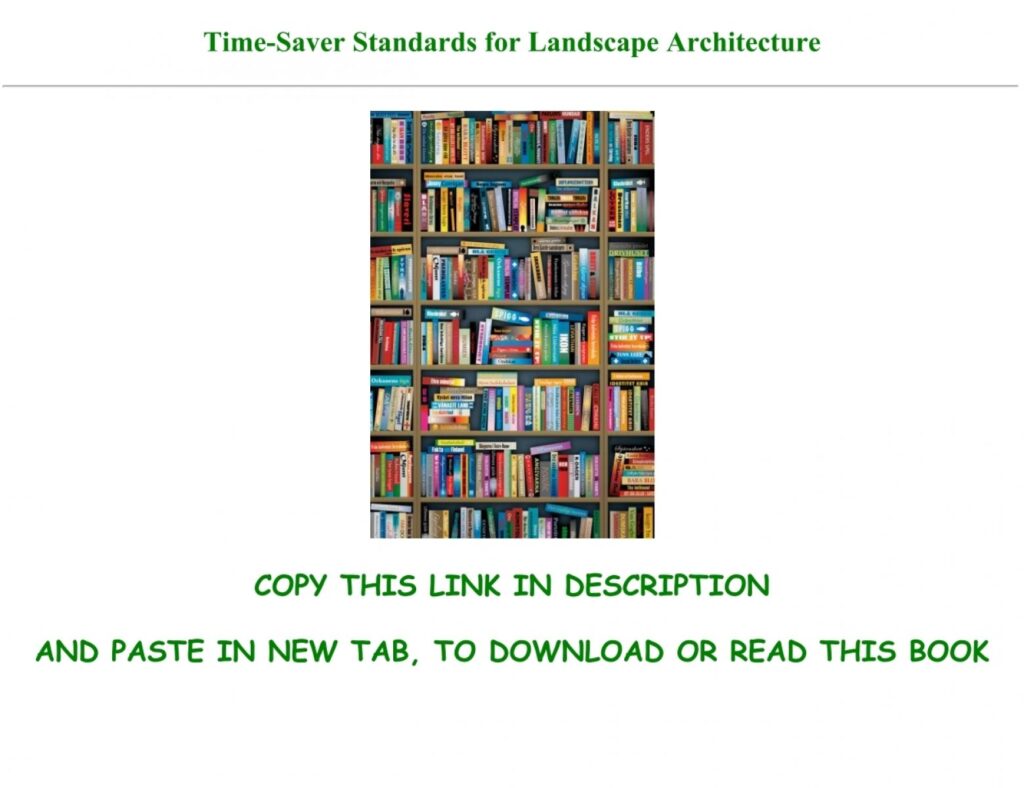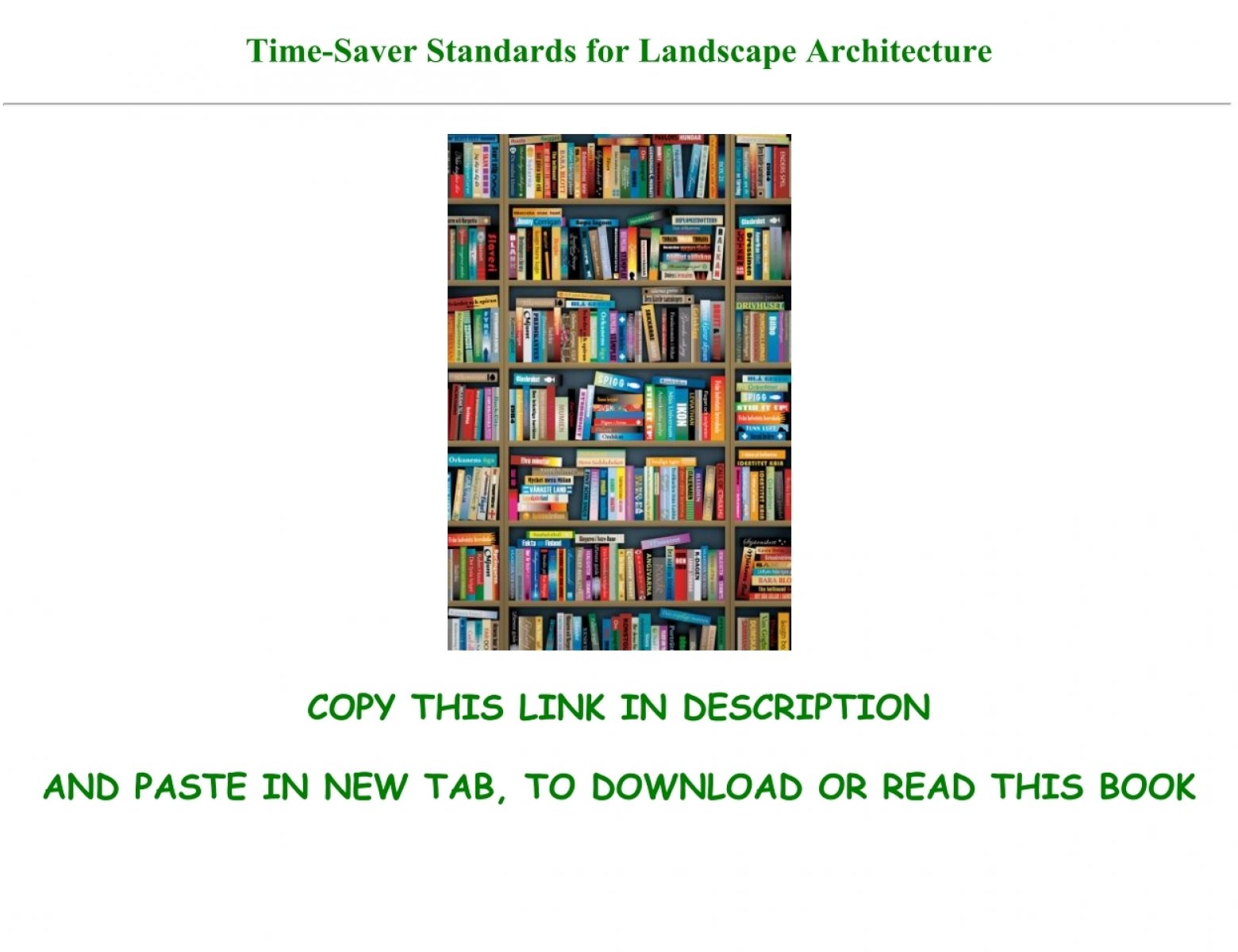
Time-Saver Standards for Landscape Architecture: A Comprehensive Guide
In the demanding field of landscape architecture, efficiency and access to reliable information are paramount. Professionals constantly seek resources that streamline the design process, provide best practices, and offer a comprehensive overview of industry standards. Enter the Time-Saver Standards for Landscape Architecture, a resource widely regarded as the quintessential reference for landscape architects, designers, and related professionals. This guide delves into the significance of this publication, its contents, and its enduring value in the modern landscape architecture landscape.
What are Time-Saver Standards?
Time-Saver Standards for Landscape Architecture isn’t just a book; it’s a meticulously compiled collection of data, standards, and guidelines designed to expedite the planning, design, and execution of landscape projects. It provides a wealth of information, from site planning and design to construction details and plant selection. Essentially, it aims to save time by providing quick access to essential knowledge, reducing the need to constantly search for disparate sources.
The History and Evolution of Time-Saver Standards
The concept of Time-Saver Standards originated with architectural design. The original series aimed to consolidate diverse building and design information into a single, readily accessible resource. The landscape architecture edition followed this model, recognizing the specific needs and challenges faced by professionals in this discipline. Over the years, the publication has undergone revisions and updates to reflect evolving industry practices, technological advancements, and environmental considerations. The Time-Saver Standards for Landscape Architecture continues to be a vital tool for both seasoned professionals and emerging designers.
Key Areas Covered in Time-Saver Standards for Landscape Architecture
The breadth of topics covered in Time-Saver Standards for Landscape Architecture is impressive. It provides an extensive overview of different aspects of landscape architecture. Some of the key areas include:
- Site Planning and Design: This section covers fundamental principles of site analysis, grading, drainage, and circulation. It provides guidelines for creating functional and aesthetically pleasing outdoor spaces.
- Planting Design: A comprehensive guide to plant selection, including information on species characteristics, climate adaptability, and maintenance requirements. It also covers planting techniques and strategies for creating sustainable landscapes.
- Construction Details: Detailed drawings and specifications for various landscape construction elements, such as paving, walls, fences, and water features. These details provide a clear understanding of construction methods and materials.
- Sustainable Design: This section addresses the growing importance of sustainable practices in landscape architecture. It covers topics such as water conservation, energy efficiency, and the use of recycled materials.
- Accessibility and Universal Design: Guidelines for creating landscapes that are accessible to people of all abilities, ensuring that outdoor spaces are inclusive and user-friendly.
- Recreation and Parks Planning: Principles and standards for designing recreational facilities, parks, and open spaces. This section covers topics such as playground design, sports field layout, and trail development.
Benefits of Using Time-Saver Standards for Landscape Architecture
The benefits of incorporating Time-Saver Standards for Landscape Architecture into professional practice are numerous. Here are some of the most significant advantages:
- Efficiency: As the name suggests, the primary benefit is time savings. Having a single, comprehensive resource eliminates the need to search through multiple sources for information.
- Accuracy: The standards and guidelines presented in the book are based on industry best practices and expert knowledge, ensuring accuracy and reliability.
- Completeness: The breadth of topics covered makes it a valuable resource for all stages of a landscape project, from initial planning to final construction.
- Consistency: By adhering to established standards, professionals can ensure consistency in their designs and documentation.
- Professional Development: The book serves as a valuable learning tool for students and emerging professionals, providing a foundation for understanding landscape architecture principles and practices.
How Time-Saver Standards Integrate with Modern Landscape Architecture Practices
While the Time-Saver Standards for Landscape Architecture has a long history, it remains relevant in today’s rapidly evolving landscape architecture field. The fundamental principles of design, construction, and sustainability remain constant, even as technology and materials change. Modern landscape architects often use the Time-Saver Standards as a starting point, supplementing it with digital tools and resources. The book’s structured approach complements Building Information Modeling (BIM) and other digital design workflows. It’s a reference that is a time saver for many firms.
The Relevance of Time-Saver Standards in the Digital Age
In an era dominated by digital tools and online resources, the enduring relevance of Time-Saver Standards for Landscape Architecture might seem surprising. However, the book offers several advantages that digital resources often lack. First, it provides a curated and vetted collection of information, eliminating the need to sift through countless online sources of varying quality. Second, it offers a structured and organized approach to landscape architecture knowledge, making it easier to find and apply relevant information. Third, it serves as a tangible and reliable reference that can be accessed even without an internet connection. Furthermore, the Time-Saver Standards provides a level of authority and credibility that is often missing from online sources. Landscape architects often use this resource.
Specific Examples of Time-Saver Standards in Action
Consider a landscape architect tasked with designing a public park. Using Time-Saver Standards for Landscape Architecture, they can quickly access information on playground design standards, sports field layouts, and trail development guidelines. They can also find detailed construction details for benches, picnic tables, and other park amenities. This allows them to efficiently develop a comprehensive design plan that meets the needs of the community. Another example would be a designer working on a residential landscape project. The Time-Saver Standards can provide guidance on plant selection, paving materials, and drainage solutions, helping them to create a beautiful and functional outdoor space. The Time-Saver Standards for Landscape Architecture help with all aspects of landscape architecture.
The Future of Time-Saver Standards
As the field of landscape architecture continues to evolve, the Time-Saver Standards for Landscape Architecture will likely adapt as well. Future editions may incorporate more digital content, such as interactive diagrams and 3D models. They may also place greater emphasis on emerging trends, such as green infrastructure, ecological restoration, and climate change adaptation. However, the fundamental principles of landscape architecture will remain constant, ensuring that the Time-Saver Standards continues to be a valuable resource for generations to come. The future looks bright for the Time-Saver Standards for Landscape Architecture.
Expert Opinions on Time-Saver Standards
Leading landscape architects and educators often praise the Time-Saver Standards for Landscape Architecture for its comprehensive coverage and practical value. Many consider it an indispensable resource for both students and professionals. “The Time-Saver Standards is an invaluable tool for any landscape architect,” says Jane Doe, a principal at a leading landscape architecture firm. “It provides quick access to essential information, saving time and ensuring accuracy.” Another expert, Dr. John Smith, a professor of landscape architecture, notes that “The Time-Saver Standards is an excellent resource for students, providing a solid foundation in landscape architecture principles and practices.” The Time-Saver Standards for Landscape Architecture are valued throughout the field.
Alternatives and Complementary Resources
While the Time-Saver Standards for Landscape Architecture is a comprehensive resource, it is not the only tool available to landscape architects. Other valuable resources include design software, online databases, and professional organizations. Some popular alternatives include Landscape Architecture Construction Details (LACD), various online plant databases, and publications from the American Society of Landscape Architects (ASLA). These resources can complement the Time-Saver Standards, providing additional information and perspectives. [See also: Landscape Architecture Construction Details: A Comparison] [See also: The Role of ASLA in Landscape Architecture]
Conclusion: The Enduring Value of Time-Saver Standards for Landscape Architecture
In conclusion, the Time-Saver Standards for Landscape Architecture remains a cornerstone resource for professionals in the field. Its comprehensive coverage, accuracy, and efficiency make it an indispensable tool for planning, designing, and executing landscape projects. Whether you are a seasoned professional or an emerging designer, the Time-Saver Standards can help you save time, improve your designs, and stay up-to-date on industry best practices. Its enduring value lies in its ability to consolidate essential knowledge into a single, readily accessible resource. The Time-Saver Standards for Landscape Architecture truly lives up to its name, helping landscape architects work smarter, not harder.

